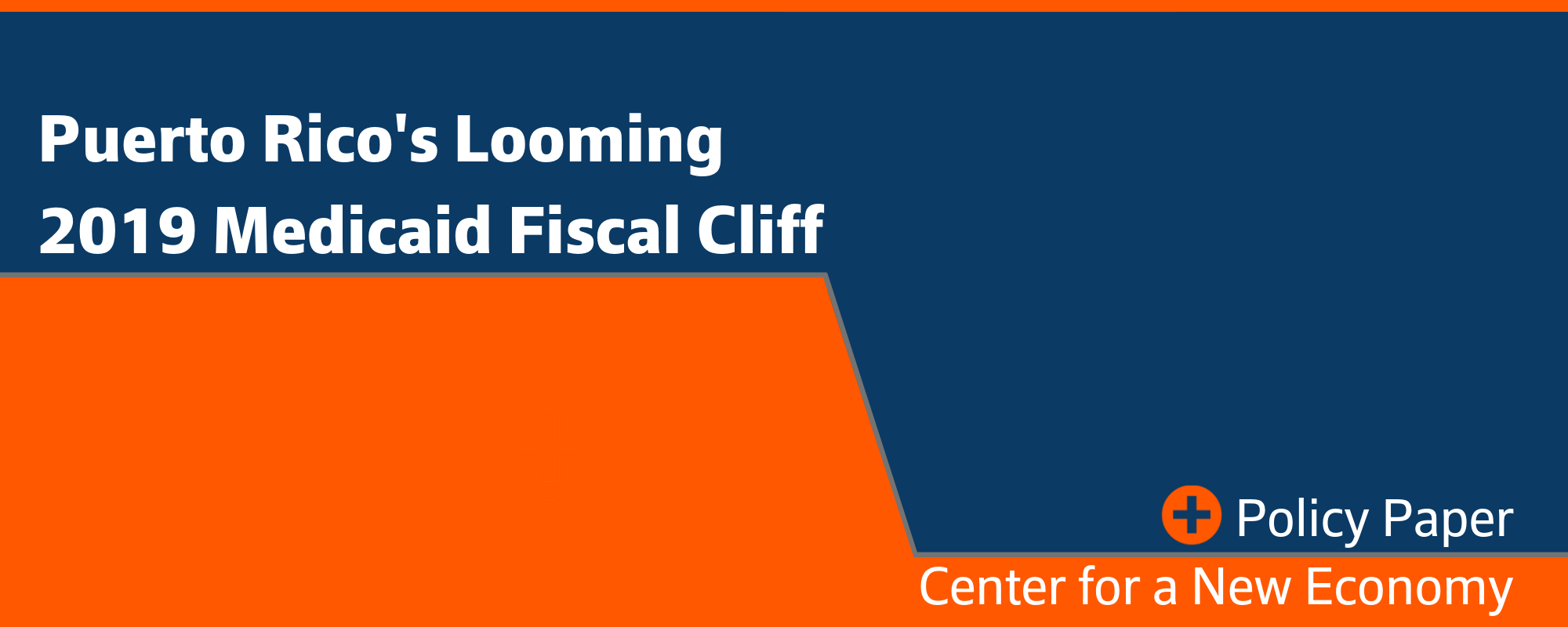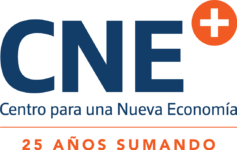
Published on September 18, 2019 / Lea en español
Ensuring basic healthcare services for the residents of Puerto Rico faces major risks in the coming months. As early as December of this year, a funding shortfall in Puerto Rico’s Medicaid program is expected to affect healthcare access and coverage to 1.5 million U.S. citizens. Those at risk are Puerto Rico’s most vulnerable: low-income families and children, pregnant women, the elderly, and people with disabilities.
Puerto Rico and its residents have experienced numerous crises and shocks in the last decades, including an economic depression dating back to 2006; a public debt crisis resulting in the largest municipal bankruptcy in U.S. history and a federally appointed fiscal oversight board pursuing deep budget cuts; a demographic crisis with population dropping by more than 600,000 residents since peaking at 3.8 million in 2004; and most recently, the devastation and cascading effects left by the hurricanes of 2017. The cumulative effect of these crises has taken a hard toll on the economic and social well-being of its people, disproportionately impacting the most vulnerable populations and communities. These interrelated crises feed on each other, propelling a vicious downward spiral.
Another potential shock is the territory’s imminent Medicaid fiscal cliff, and ensuing public health crisis. In the past, temporary lifelines to Puerto Rico’s Medicaid program have prevented a total system collapse, but by the same token, these short-term extensions of supplemental funding have thwarted efforts to completely reform the system and make it more effective. The uncertainty caused by this situation is highly detrimental to all stakeholders, especially people whose health and well-being depends on receiving vital care but have few resources to make ends meet in this challenging economic environment.
Differences in Puerto Rico’s Medicaid Program
The U.S. Medicaid program was created to provide vital healthcare services to financially and medically needy populations. In Puerto Rico, however, that same population that is adversely affected by a disparate and inadequate federal funding structure. Medicaid programs in the states benefit from an open-ended federal financing structure, receiving federal funds as a function of actual costs and needs. In Puerto Rico, where median household income stood at $19,775 in 2017, compared to $42,009 in Mississippi, the poorest state, and $57,652 in the United States as a whole, the program has been chronically underfunded. In the poverty-ridden territory, funding limitations further constrain program delivery evidenced in the form of lower eligibility levels, lower federal funding, fewer mandatory benefits, lower provider payments, and lower spending per enrollee.
Lower eligibility levels: To determine income eligibility for participation in Medicaid, Puerto Rico uses the Puerto Rico Poverty Level (“PRPL”) and not the Federal Poverty Level (“FPL”) as in the states, which results in a significantly lower income eligibility threshold. The PRPL is approximately 45% of the FPL for an individual, and 34% for a family of four.
Lower federal funding: Medicaid programs in the U.S. benefit from an open-ended financing structure, receiving federal funds based on actual costs and needs. States with the highest per capita incomes of the U.S. enjoy a Medicaid federal matching rate of 50%, while the poorest, Mississippi, received a Federal Medical Assistance Percentage (“FMAP”) of 76.4% in fiscal year 2019. If Puerto Rico’s FMAP were “calculated by the same statutory formula used for the 50 states and D.C., Puerto Rico’s FMAP would be 83%, although the unbounded FMAP would be 93.34%.” In addition to the lower federal share, Puerto Rico’s Medicaid federal financing is also subject to an annual ceiling or cap, operating effectively as a block grant. Puerto Rico receives an arbitrarily capped allotment, known as the Section 1108 cap, typically resulting in an effective Medicaid federal match rate below 15%. Puerto Rico’s federal funding was capped at $367 million in FY2019, while Medicaid expenditures in the island totaled $2.7 billion. The projected FY2020 cap is expected to be $375.1 million, despite spending projections adding up to $2.8 billion. As per current law, Puerto Rico will also have access to $446 million under the Patient Protection and Affordable Care Act (“ACA”) Section 1323, and $59 million under Social Security Administration (“SSA”) Section 1935(e), also referred to as the Enhanced Allotment Plan (“EAP”), which helps cover prescriptions drugs costs to beneficiaries dually eligible for Medicaid and Medicare, for a total of $880 million in federal spending.
Fewer mandatory benefits: Notwithstanding the great needs and demands for acute and long-term care services – which will likely continue to grow in tandem with the aging population trend and the rising prevalence of chronic health problems – Puerto Rico’s Medicaid program does not cover all mandatory Medicaid benefits. Long-term services, home and community-based services to older adults and people with disabilities with functional limitations and chronic health conditions, are examples of support offered in U.S. states but not available to the residents of Puerto Rico.
Lower provider payments: Disproportionately low provider payment rates and its negative effect on provider availability, and quality and access to care, is a major obstacle for Puerto Rico. The majority of municipalities (i.e. 72 of 78) of Puerto Rico are deemed “medically underserved areas” due to the shortage of medical and healthcare professionals. The Medicaid provider reimbursement rate in Puerto Rico for primary care services from July 2016 to July 2017 was 19% of the Puerto Rico Medicare fee compared to 66% in the U.S. Similarly, maternity services were reimbursed at 50% of the Puerto Rico Medicare fee vs. 81% in the U.S. The substantial differences between Puerto Rico’s Medicaid reimbursement rates and those in the states and the uncertainties regarding the island’s Medicaid financing structure, have played a role in the exodus of physicians and healthcare providers. The number of doctors has decreased from approximately 14,000 in 2006 to currently close to 9,000. There is a particularly acute deficiency of specialty care providers.
Lower Medicaid spending per enrollee: Total Medicaid spending per enrollee is significantly lower in Puerto Rico when compared to all 50 states. According to FY 2020 projections by the Medicaid and CHIP Payment and Access Commission (“MACPAC”), average benefit spending per full year enrollee in Puerto Rico will be $2,144, representing 64% of the lowest per capita spending state ($3,342), 32% of the median ($6,763), and 16% of the highest per capita spending state ($13,429).
Increased Healthcare Needs
Less funding has, in effect, translated to increased needs. The percent of adults reporting fair or poor health in 2017 reached 37.1% in Puerto Rico, compared to 25.3% in Mississippi, and 18.4% in the U.S. The healthiest jurisdiction, according to this indicator, was the District of Columbia reporting 10.8%. Disparities in chronic health indicators are also significant. Diabetes prevalence in Puerto Rico in 2017 was 17.2%, compared to 10.5% in the U.S. Asthma and high blood pressure prevalence was 12.2% and 44.7% in Puerto Rico, compared to 9.4% and 32.3% in the U.S, respectively. A robust healthcare system with adequate federal funding could help mitigate the high prevalence of chronic conditions on the island.
Necessary Congressional Action
The chronic underfunding of the island’s Medicaid program has historically placed an undue fiscal burden on Puerto Rico’s budget and prompted federal action. During the last decade, Congress has enacted legislation to provide limited, temporary supplemental funding and avoid a massive healthcare crisis. In 2009, additional federal funds for Puerto Rico’s Medicaid program were appropriated through the American Reinvestment and Recovery Act (“ARRA”), followed by the ACA in 2010, the Consolidated Appropriations Act of 2017, and most recently, through the Bipartisan Budget Act (“BBA”) of 2018 following the devastating 2017 Atlantic hurricane season. In the aftermath of Hurricanes Irma and Maria impacting the island on September 2017, Congress provided an additional $4.8 billion to Puerto Rico’s Medicaid program beyond the annual Section 1108 cap, time-limited funds that were made available from January 1, 2018 to September 30, 2019. The expiration date authorizing the use of that last tranche of funding is soon approaching, and all other temporary federal funds are expected to be exhausted shortly thereafter.
Only prompt Congressional action can help avert a health care crisis in Puerto Rico. If Congress fails to act, it could lead to catastrophic direct and indirect effects. The Medicaid and CHIP Payment and Access Commission (“MACPAC”) estimated that enrollment at the current level of benefits would need to decrease between 36% (455,475) to 53% (669,943) if no new federal funds are made available. The Fiscal Oversight and Management Board for Puerto Rico has warned that “absent action by Congress, by fiscal year 2021, the Commonwealth’s Medicaid costs are projected to comprise roughly 23% of the General Fund’s budget.”
The FMAP that applies to Puerto Rico’s Medicaid program should be computed using the same formula used for the states, considering the average per capita income of Puerto Rico relative to the U.S. national average. To ensure that the most vulnerable populations of Puerto Rico have access to a more robust, predictable, reliable, and accessible Medicaid healthcare system, Congress must act quickly and remove the federal cap on Medicaid funding altogether and compute the FMAP using the same average per capita income-based formula as done for the states. Providing Puerto Rico with an adequate level of federal funds for its Medicaid program will also help it return to a path of fiscal stability and economic growth. The urgency of this matter cannot be overstated. Congressional action is promptly needed to stave off another historic humanitarian crisis.
When designing the solution, policy deliberations and prescriptions must be framed within the proper context. Policymakers must remain keenly aware of the historic critical juncture Puerto Rico is traversing and the larger moral imperatives at play. Puerto Rico’s current dire economic, fiscal, demographic, and post-natural disaster recovery and reconstruction reality must be an essential part of the broader equation. This critical juncture presents an opportunity for Congress to redress a historical wrong, strengthen Puerto Rico’s fragile healthcare system, improve access to critical health services for vulnerable populations, and make headway towards putting Puerto Rico on a stronger fiscal and economic footing.
Further, more than a last-minute temporary fix is needed to provide Puerto Rico with a reliable and sustainable healthcare system. A permanent, long-term fix to Puerto Rico’s Medicaid program is needed to once and for all guarantee comprehensive, accessible, quality care to low-income families, children, the elderly, and people with disabilities.
